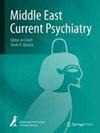Alexithymia, oral behaviors, and temporomandibular disorders: a dark triad?
IF 1.6
Q3 PSYCHIATRY
引用次数: 0
Abstract
Alexithymia is a condition in which cognitive processing of emotions is impaired. Associations between alexithymia and temporomandibular disorders (TMD) have been described in multiple studies, yet the coexistence or influence of oral behaviors has never been addressed. This study aimed to clarify the relationship between alexithymia, oral behaviors, and temporomandibular pain disorders. A total of 264 participants were included in this study. The mean age was 25.70 ± 5.99 years, with a range from 18 to 65 years. Eighty-two (31.1%) were possibly alexithymic, and 93 (35.2%) were alexithymic. A total of 12.5% of the participants were at high risk for TMD. With respect to oral behavior risk, 62.5% were at low risk, and 35.2% were at high risk. Alexithymia appeared to be a positive predictor of TMD risk (p < 0.001). Participants with high-risk oral behaviors were found to have an increased likelihood of TMD risk (p < 0.001). Moreover, both high-risk oral behavior and alexithymia correlated with increased somatic symptom burden levels (p < 0.001). Pain disorders exert significant distress on individuals and lead to poorer quality of life. Understanding the association of alexithymia, somatic symptom burden, and coping strategies with oral behaviors and temporomandibular pain disorders can help improve the management of this condition. By tailoring the chosen therapy to the dominant co-existing psychosocial comorbidities in TMD patients, the risk of treatment failure or relapse may be diminished.亚历山大症、口腔行为和颞下颌关节紊乱:黑暗三重奏?
情绪失调症是一种情绪认知处理能力受损的病症。有多项研究描述了亚历山大症与颞下颌关节紊乱症(TMD)之间的关联,但从未涉及口腔行为的共存或影响。本研究旨在阐明lexithymia、口腔行为和颞下颌疼痛疾病之间的关系。本研究共纳入 264 名参与者。平均年龄为(25.70 ± 5.99)岁,介于 18 岁至 65 岁之间。82人(31.1%)可能患有自闭症,93人(35.2%)患有自闭症。共有 12.5% 的参与者属于 TMD 高危人群。在口腔行为风险方面,62.5%为低风险,35.2%为高风险。Alexithymia 似乎是预测 TMD 风险的一个积极因素(p < 0.001)。发现有高风险口腔行为的参与者发生 TMD 风险的可能性更高(p < 0.001)。此外,高危口腔行为和自闭症都与躯体症状负担水平的增加相关(p < 0.001)。疼痛疾病会给个人带来极大的痛苦,并导致生活质量下降。了解lexithymia、躯体症状负担和应对策略与口腔行为和颞下颌关节疼痛疾病的关系有助于改善对这种疾病的治疗。根据 TMD 患者并存的主要社会心理并发症来选择治疗方法,可以降低治疗失败或复发的风险。
本文章由计算机程序翻译,如有差异,请以英文原文为准。
求助全文
约1分钟内获得全文
求助全文
来源期刊

Middle East Current Psychiatry
Medicine-Psychiatry and Mental Health
CiteScore
3.00
自引率
0.00%
发文量
89
审稿时长
9 weeks
 求助内容:
求助内容: 应助结果提醒方式:
应助结果提醒方式:


